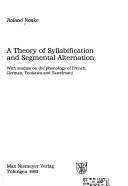| Listing 1 - 4 of 4 |
Sort by
|
Book
ISBN: 1283428261 9786613428264 1614510695 1614510687 1614510679 9781614510673 Year: 2011 Publisher: Berlin ; Boston : De Gruyter Mouton,
Abstract | Keywords | Export | Availability | Bookmark
 Loading...
Loading...Choose an application
- Reference Manager
- EndNote
- RefWorks (Direct export to RefWorks)
Sign languages and spoken languages have an equal capacity to communicate our thoughts. Beyond this, however, while there are many similarities, there are also fascinating differences, caused primarily by the reaction of the human mind to different modalities, but also by some important social differences. The articulators are more visible and use larger muscles with consequent greater effort. It is difficult to visually attend to both a sign and an object at the same time. Iconicity is more systematic and more available in signs. The body, especially the face, plays a much larger role in sign. Sign languages are more frequently born anew as small groups of deaf people come together in villages or schools. Sign languages often borrow from the written form of the surrounding spoken language, producing fingerspelling alphabets, character signs, and related signs. This book examines the effects of these and other differences using observation, experimentation and theory. The languages examined include Asian, Middle Eastern, European and American sign languages, and language situations include home signers and small village signers, children, gesturers, adult signers, and non-native signers.
Grammar, Comparative and general - Phonology, Comparative. --- Sign language -- Grammar, Comparative. --- Sign language -- History. --- Sign language - Phonology, Comparative. --- Sign language -- Variation. --- Sign language. --- Sign language --- Grammar, Comparative and general --- Languages & Literatures --- Philology & Linguistics --- Phonology, Comparative --- Phonology, Comparative. --- Comparative phonology --- Contrastive phonetics --- Contrastive phonology --- Phonetics, Contrastive --- Phonology, Contrastive --- Deaf --- Gesture language --- Contrastive linguistics --- Language and languages --- Gesture --- Signs and symbols --- Phonetics. --- Phonology. --- Sign Language. --- Linguistics --- Philology --- Sign language - Phonology, Comparative --- Grammar, Comparative and general - Phonology, Comparative
Book
ISBN: 9516782558 9789516782556 Year: 1979 Volume: no. 7 Publisher: Jyväskylä University of Jyväskylä
Abstract | Keywords | Export | Availability | Bookmark
 Loading...
Loading...Choose an application
- Reference Manager
- EndNote
- RefWorks (Direct export to RefWorks)
Finnish language --- Phonetics --- Comparative linguistics --- English language --- Grammar, Comparative and general --- Phonologie comparée --- Phonology, Comparative --- Finnish --- English --- -Finnish language --- -Grammar, Comparative and general --- -Comparative grammar --- Grammar --- Grammar, Philosophical --- Grammar, Universal --- Language and languages --- Philosophical grammar --- Linguistics --- Philology --- Baltic-Finnic languages --- Germanic languages --- -Finnish --- -English --- Grammar, Comparative --- -Phonology, Comparative --- Phonologie comparée --- Comparative phonology --- Contrastive phonetics --- Contrastive phonology --- Phonetics, Contrastive --- Phonology, Contrastive --- Contrastive linguistics --- Phonology, Comparative&delete& --- Finnish. --- Grammar, Comparative and general - Phonology, Comparative --- English language - Phonology, Comparative - Finnish --- Finnish language - Phonology, Comparative - English
Book
ISBN: 9789027208293 9789027269485 9027269483 9027208298 1322490317 Year: 2014 Volume: 12 Publisher: Amsterdam, Netherlands ; Philadelphia, Pennsylavania : John Benjamins Publishing Company,
Abstract | Keywords | Export | Availability | Bookmark
 Loading...
Loading...Choose an application
- Reference Manager
- EndNote
- RefWorks (Direct export to RefWorks)
The paper argues that both nouns and adjectives are interpreted as relational in the construct state. Accordingly, relational nouns can all be inflected in the construct state, and so can some sortal nouns which can be coerced to a relational interpretation. Similarly, relational adjectives can all be inflected in the construct state, and so can some predicative adjectives which can be reinterpreted as relational when in construct with a relational annex. The present approach accounts for the non-modifiability of such relational annex, and the restriction of its denotation to intra-individual
Afroasiatic languages --- Grammar, Comparative and general --- Grammar, comparative, and general --- Grammar --- Phonology, Comparative --- Morphology --- Phonetics --- Grammar. --- Phonology, Comparative. --- Morphology. --- Phonetics. --- Afrasian languages --- Afro-Asiatic languages --- Erythraic languages --- Hamito-Semitic languages --- Semito-Hamitic languages --- Morphology (Linguistics) --- Comparative phonology --- Contrastive phonetics --- Contrastive phonology --- Phonetics, Contrastive --- Phonology, Contrastive --- Contrastive linguistics --- E-books --- Linguistics --- Philology --- Afroasiatic languages - Grammar --- Grammar, Comparative and general - Phonology, Comparative --- Grammar, comparative, and general - Morphology --- Afroasiatic languages - Phonetics --- Grammar, Comparative and general Morphology

ISBN: 3484302968 3111594793 9783111594798 9783484302969 Year: 2011 Volume: 296 Publisher: Tübingen
Abstract | Keywords | Export | Availability | Bookmark
 Loading...
Loading...Choose an application
- Reference Manager
- EndNote
- RefWorks (Direct export to RefWorks)
Theory of Syllabification and Segmental Alternation: With Studies on the Phonology of French, German, Tonkawa and Yawelmani (Linguistische Arbeiten)
Autosegmental theory [Linguistics ] --- Division of words --- Phonologie autosegmentale --- Splitsing in lettergrepen --- Splitsingsregels --- Syllabation --- Syllabication --- Syllabification --- Verdeling in lettergrepen --- Word division --- Syllabication. --- Phonology, Comparative. --- Tonkawa language --- Yawelmani dialect --- Phonologie comparée --- Tonkawa (Langue) --- Yawelmani (Dialecte) --- Phonologie comparée --- Grammar, Comparative and general --- Autosegmental theory (Linguistics) --- French language --- German language --- Français (Langue) --- Allemand (Langue) --- Phonology --- Phonologie --- Grammar [Comparative and general ] --- Phonology [Comparative ] --- Autosegmental phonology --- Linguistics --- Comparative phonology --- Contrastive phonetics --- Contrastive phonology --- Phonetics, Contrastive --- Phonology, Comparative --- Phonology, Contrastive --- Contrastive linguistics --- Line-end wordbreaking --- Wordbreaking --- Wordbreaks --- Morphology --- Philology --- Grammar, Comparative and general - Phonology, Comparative.
| Listing 1 - 4 of 4 |
Sort by
|

 Search
Search Feedback
Feedback About UniCat
About UniCat  Help
Help News
News